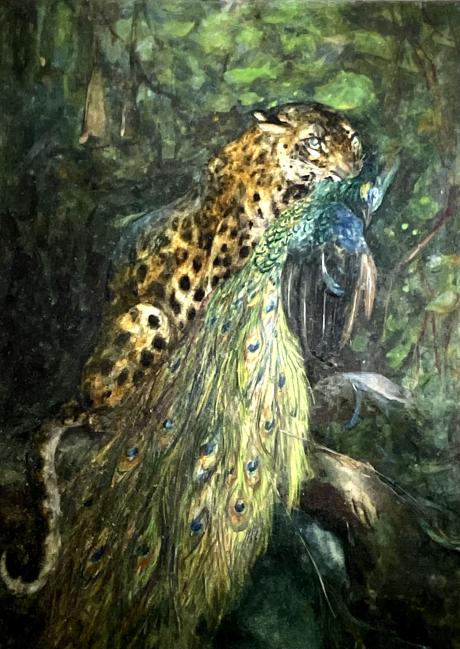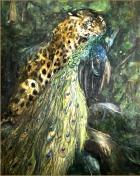Signed and dated 1918 Inscribed as title on a label verso
The green peafowl is native to Burma and Java, while the blue comes from India and Sri Lanka. These countries are home to a wide range of large hunters that are potential peacock predators, and peacocks have fallen prey to the likes of large jungle cats such as leopards and tigers, but also to smaller animals, like the mongoose or stray dogs.
Indian peacocks (Pavo cristatus) are some of the globe's most unforgettable and physically stunning animals, what with their vivid decorative trains. The females of the species are nowhere near as showy in the feather department -- and they're known as peahens, rather than peacocks. When talking about both of the genders, the term is peafowl. Indian peahens are visually a lot more lackluster than peacocks, and for good reason pertaining to the survival of offspring. While the males have to be conspicuous to gain the attentions of females for breeding, the goal of the females is to stay as far under the radar as possible. If peahens can mix in seamlessly with the rest of their environment, potential predators might miss them while egg incubation is going on. The differences in plumage are a practical survival adaptation against predation.
Spotting Indian peacocks remotely is often a piece of cake for their predators. Some of their most common predators are tigers, leopards, civets, wild canines and mongooses. The train is extremely problematic for Indian peacocks, as it sometimes blocks them from being able to see dangerous predators that might be coming up to them from the back. When predators try to tug on their trains, the fowl sometimes get lucky. Their feathers often simply drop to the ground -- enabling the peacocks to bolt the scene immediately.
Although peacocks are more vulnerable to predation by these animals, peahens experience it, too. Flying isn't a common behavior in Indian peafowls, although running is. When they're trying to escape predators, they do often resort to flying, however. Indian peafowl are also extremely vocal when in protective mode. If they suspect impending peril, they alert others around them by partaking in lots of noisy and shrill squawking. This also comes in handy for alerting different animals that might be nearby, such as deer. Indian peafowl also retreat to high trees at night -- another means of staying away from predators. The diurnal birds roost in sizable groups.
Cuthbert Edmund Swan was born in Ballyragget, Co Kilkenny, Ireland. He was educated at Seaford College, Sussex before he and his brother Edwin went on to study at the Academie Julien in Paris. On their return to London they settled in Camden Town. Cuthbert Edmund Swan was a teacher of drawing at the Central School of Arts and Crafts, especially animals. The latter was Irish, the son of John Macallan Swan, who had himself built up a career as a painter of animals, mainly big cats. Cuthbert followed in his father’s footsteps and he, too, was preoccupied with the study and depiction of zoo animals, notably the lions, jaguars, pumas and other big cats, which he regularly exhibited at the RA and other venues.It seems that Cuthbert and his brother, Edwin Swan, probably in the late 1880s, had studied at the Académie Julian in Paris - part of that tide of British students washing over the Channel, eager to become acquainted with some of the most radical art and art teaching available in western Europe at the time. Here, of course, students would meet fellow artists from many different countries and would also encounter some of the most exciting art of the day, notably, the work of the Impressionists. Within the Académie, the emphasis was on scrutinising an image, memorising, recalling and drawing from memory, until the student acquired considerable fluency and could then – of greatest importance – employ that skill as a vehicle for personal expressiveness. Furthermore, when Cuthbert and Edwin Swan arrived back in England, they settled in Camden Town for a while and met and painted with Walter Sickert, Lucien Pissarro and the young Robert Bevan (also lately returned form the Académie Julian).
He spent some time in India and was particularly fond of painting big cats, especially leopards. He taught animal drawing at the Central School of Arts and Crafts and exhibited at the Royal Academy, Royal Society of Oil Painters, Paris Salon and elsewhere. Works by him are in the collections of Birmingham Museum and Art Gallery, Llandudno Museum and elsewhere.
He was the son of the eminent painter and sculptor John Macallan Swan R.A. who spent considerable time at London Zoo studying and drawing animals there, particularly the big cats. Before becoming an artist and teacher of animal drawings for L C C School of Arts and Crafts, Cuthbert Swan had been a sailor and a scene painter. He specialised in animals working in oils, watercolours and pastels to produce his paintings and, despite working in India for a while, spent most of his life in Hampstead. He became a member of the Feline School.
He exhibited 66 times in England at the Royal Academy (from 1893) and the Royal Institute of Oil Painters plus others at the Paris Salon, with titles such as "Duke - a study of a lion"; "Jaguars at Play" and "Puma and cubs". His brother Edwin was a portrait painter.
Bibliography
Dictionary of British Animal Painters – J.C. Wood
Dictionary of British Artists Working 1900-1950 - Grant Waters
Dictionary of Victorian Painters - Christopher Wood
Dictionary of British Artists 1880-1940 - Johnson and Greutzner



